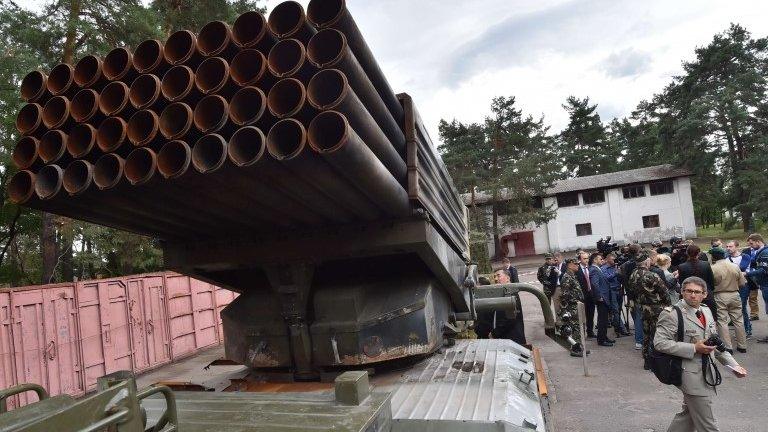Putin problem gives Nato headache
- Published
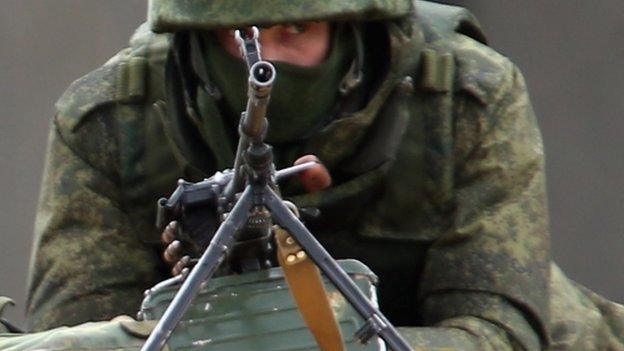
Members of NATO are alarmed about the perceived threat from Russia
The meeting of Nato foreign ministers in Brussels this week will be dominated by the crisis in Ukraine and the wider ramifications of the deteriorating relationship between Moscow and the West.
For the Atlantic Alliance, the onset of a new mini-Cold War is hardly a welcome development.
Nonetheless it offers both a challenge and an opportunity.
Can Nato move swiftly to counter the resurgent Russian threat?
Can it use the strains with Moscow to establish an appropriate level of defence spending that shares the military burden more fairly?
But there is risk here too. Can Nato governments make an accurate assessment of just what the new Russian threat amounts to?
Some member governments, like those of Poland and the Baltic Republics are alarmed - very alarmed.
Having been part of the former Soviet Union or the Warsaw Pact they know Moscow well and believe that the curious form of warfare conducted by the Russian President Vladimir Putin towards Ukraine might one day be directed against them.
Indeed formulating a response to this supposedly new form of warfare - what some have dubbed "hybrid war" - seems to be dominating Nato's thinking.
"Hybrid war" is an amalgam of overt and covert military power; a combination of bullying and subversion along with just a dash of deniability - all intended to make a full-scale response that much harder.
However, there are those who argue that this concept of "hybrid war" is not necessarily new and that in any case, erecting it into a great new threat to Nato territory risks a potentially dangerous over-statement of the problem.
Beefed-up response
In practical terms, Nato's response to Russia's aggression against Ukraine has been swift, albeit limited.
Allies have pitched in to bolster air patrols over the Baltic Republics; important given that Moscow has significantly expanded its incursions into western air-space.
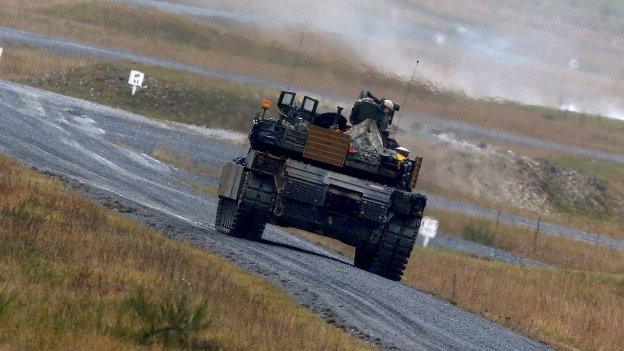
Abrams tanks have been returned to Europe
A regular pattern of military exercises has also been established in eastern Europe to bolster reassurance.
British tanks, for example, recently took part in an exercise in Poland.
The US is very much in the vanguard of these activities.
Indeed a small number of US Abrams tanks and Bradley armoured vehicles have been returned to Europe.
The numbers involved are small - about 50 vehicles so far - but it marks a significant reversal of the trend.
In April 2013, the last US tank left Germany as part of the post-Cold War drawdown of US forces.
In January of this year a small number arrived back on German soil.
At the end of November, the commander of US forces in Europe said that 100 more pieces of heavy armour were on their way and plans were being drawn up to deploy some of them further east.
Nato's new Secretary General Jens Stoltenberg wants to see a clear timetable of military exercises and troop rotations established for the Baltic Republics and Poland through to the end of 2015.
New plan
Meanwhile, Nato is firming up its so-called Readiness Action Plan, external - a sweeping set of proposals to create more flexible and deployable forces.
The spearhead of the Nato response force will be about a brigade in strength able to move at very short notice indeed.
The hope is that it will have an interim capability in 2015 but much of the discussion at Nato relates to exactly how this will be constituted and crucially, what forces will follow on behind it.
Nato countries are also stepping up support for Ukraine but with understandable caution.
The US is providing it with a variety of non-lethal items like night-vision devices; bomb disposal robots, radios, body armour, helmets, shelters, fuel pumps, and diesel generators.
There is talk of Humvee utility vehicles and mortar-locating radar too.
Nato itself has established five trust funds to bolster Ukraine's defence capabilities in the medium-term.
But what Kiev really wants is weaponry and that for now is not forthcoming.
Experts though stress that while military reassurance for a threatened ally is crucial, it should be part of a broader policy.
Officials speak of the need for a "whole government response", co-ordinating a variety of elements: socio-economic factors (how are Russian-speaking minorities treated for example); strategic communications; economic pressure and so on.
Though in the same breath officials accept that "whole government responses" are not necessarily something that western governments are very good at.
But surely the first thing to do is to make an accurate assessment of the nature of the threat.
And this is where the term "hybrid warfare" is so problematic.
Disinformation campaigns
I recently spent a whole day at a conference with senior officials and experts who struggled to come up with any clear definition of the concept.
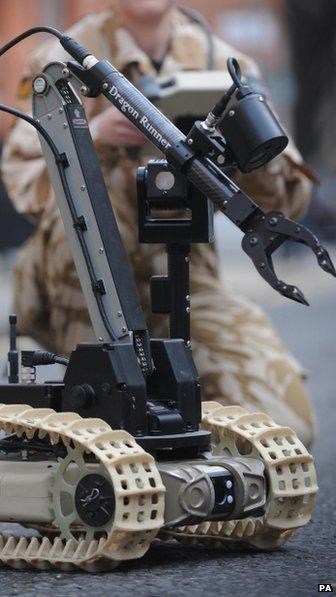
The US is providing Ukraine with bomb disposal robots
Indeed many of the suggestions were so broad, lumping in a variety of examples from the world's ungoverned spaces, as to leave any definition bereft of any practical utility.
Russia analyst Keir Giles says that "hybrid warfare" is a concept that goes back a long way.
Some aspects, he admits may be novel - for example the use of cyber-elements and the social media - but these he says are analogous to the sorts of disinformation campaigns that came from Moscow in earlier times.
The problem he insists is that "we have been slow to recognise this because of a loss of institutional memory. The deep wells of expertise on Russia that used to exist in Nato governments have largely run dry."
Giles also argues that any proper analysis must seek to understand where Russia is coming from and its peculiar strengths.
Many argue that Mr Putin's campaign in Ukraine is failing, bringing opprobrium and economic pressure on Moscow in equal measure.
But, says Giles, see things according to Moscow's criteria and you get a very different result.
"The Georgia war was seen by the West as a setback for Moscow," he notes, "but by the Russians as a success."
"Mr Putin", he argues, "has secured the Russian information space and has now set up an alternative reality which is gaining some modest traction, even in the West."
Analysing Putin
Two other scholars, Jacob Kipp and Roger McDermott, have sought to analyse the underpinnings of Mr Putin's actions.
In a soon-to-be-published article they note that "the Kremlin saw the revolution in Ukraine as Western-backed, not representing the will of the majority and sweeping from power the legitimate president much like earlier colour revolutions".
Moscow, they say, "also saw Ukraine in this context as too strategically important to ignore", amid "fears that such a colour revolution may pose a direct threat to Russian national security."
Their conclusion is crucial to an assessment of Mr Putin's longer-term goals.
"Russia has acted," they say, "whether we like it or not, in its own national security interests. That is a very different proposition, to suggesting that any Russian president would authorise an attack on a Nato member state."
The crucial thing for Nato is to get this challenge into perspective and not to stoke up its own side of a new Cold War.
Many experts believe that Russia should be seen for what it is; a country acting more out of weakness rather than strength.
Nonetheless, the Ukraine crisis has shown Mr Putin to be a master of making policy on the hoof, exploiting weaknesses; setting many hares running and following up those that seem to make the most headway.
As one veteran western diplomat told me, "the essence of the Russian approach is to target Nato's key strengths - its cohesion and solidarity. That in essence is the threat from Mr Putin's 'hybrid war'."
Moscow's approach is carefully calibrated to avoid a big response and Nato must find ways of responding as an alliance to what at first may appear to be pinpricks against one of its members, but an attack nonetheless that could gain in intensity if no adequate response is forthcoming.
- Published26 November 2014
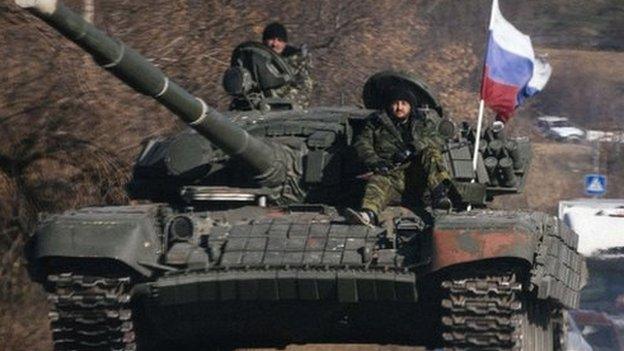
- Published18 November 2014

- Published4 September 2014

- Published29 August 2014
